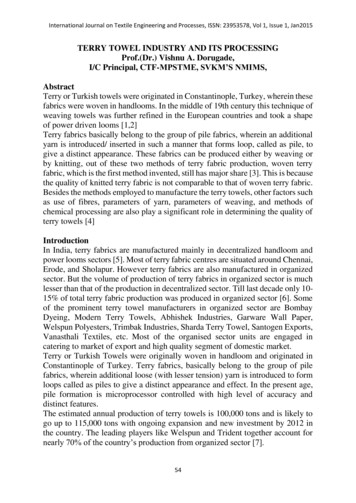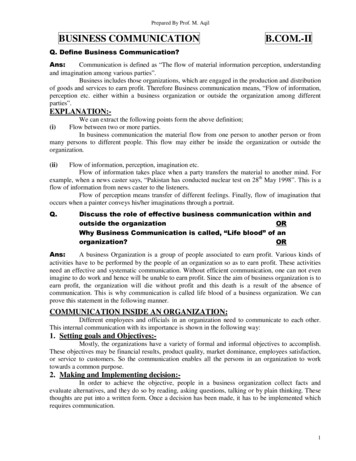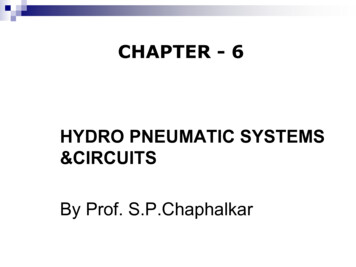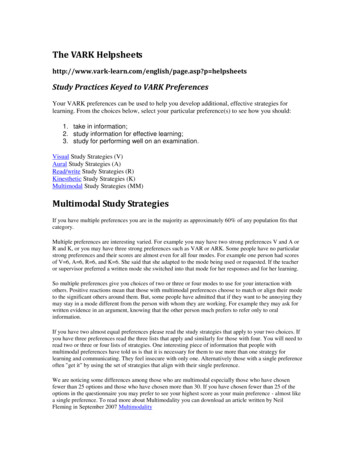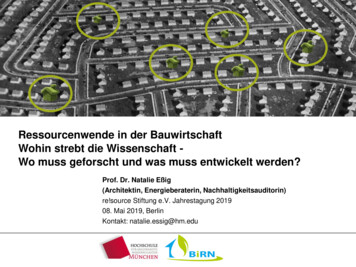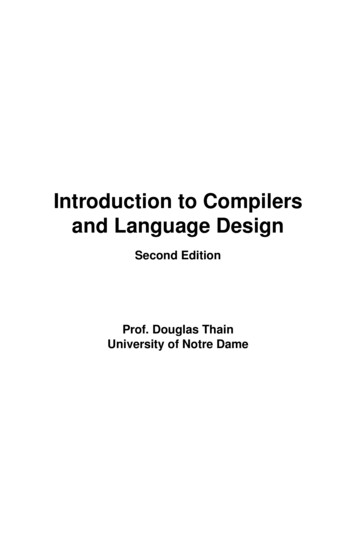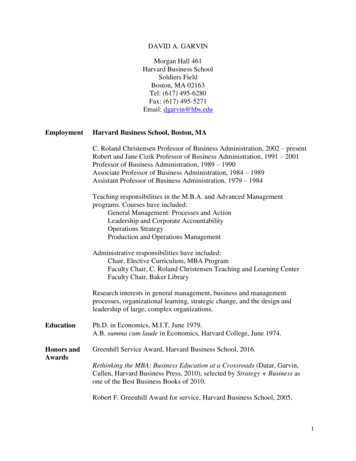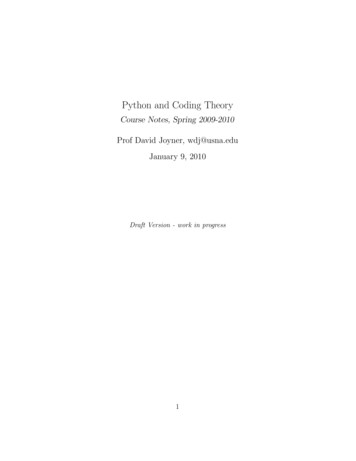
Transcription
Python and Coding TheoryCourse Notes, Spring 2009-2010Prof David Joyner, wdj@usna.eduJanuary 9, 2010Draft Version - work in progress1
Acknowledgement: There are XKCD comics scattered throughout (http://xkcd.com/), created by Randall Munroe. I thank Randall Munroe for licensing hiscomics with a a Creative Commons Attribution-NonCommercial 2.5 License, whichallows them to be reproduced here. Commercial sale of his comics is prohibited.I also have made use of William’s Stein’s class notes [St] and John Perry’s classnotes, resp., on their Mathematical Computation courses.Except for these, and occasional brief quotations (which are allowed under FairUse guidelines), these notes are copyright David Joyner, 2009-2010, and licensedunder the Creative Commons Attribution-ShareAlike License.Python is a registered ere are some things which cannot be learned quickly,and time, which is all we have,must be paid heavily for their acquiring.They are the very simplest things,and because it takes a man’s life to know themthe little new that each man gets from lifeis very costly and the only heritage he has to leave.- Ernest Hemingway (From A. E. Hotchner, Papa Hemingway, Random House, NY, 1966)2
Contents1 Motivation82 What is Python?92.1 Exercises . . . . . . . . . . . . . . . . . . . . . . . . . . . . . . 113 I/O3.13.23.33.4Python interface . .Sage input/outputSymPy interface . .IPython interface .4 Symbols used in Python4.1 period . . . . . . . .4.2 colon . . . . . . . . .4.3 comma . . . . . . . .4.4 plus . . . . . . . . .4.5 minus . . . . . . . .4.6 percent . . . . . . . .4.7 asterisk . . . . . . .4.8 superscript . . . . . .4.9 underscore . . . . . .4.10 ampersand . . . . . .1212131616.16171718191920202021215 Data types215.1 Examples . . . . . . . . . . . . . . . . . . . . . . . . . . . . . 225.2 Unusual mathematical aspects of Python . . . . . . . . . . . . 246 Algorithmic terminology276.1 Graph theory . . . . . . . . . . . . . . . . . . . . . . . . . . . 276.2 Complexity notation . . . . . . . . . . . . . . . . . . . . . . . 297 Keywords and reserved terms in Python7.1 Examples . . . . . . . . . . . . . . . .7.2 Basics on scopes and namespaces . . .7.3 Lists and dictionaries . . . . . . . . . .7.4 Lists . . . . . . . . . . . . . . . . . . .7.4.1 Dictionaries . . . . . . . . . . .3.333642434344
7.5Tuples, strings . . . . . . . . . . . . . . . . . . . . . . . . . . . 477.5.1 Sets . . . . . . . . . . . . . . . . . . . . . . . . . . . . 498 Iterations and recursion8.1 Repeated squaring algorithm . . . . . .8.2 The Tower of Hanoi . . . . . . . . . . .8.3 Fibonacci numbers . . . . . . . . . . .8.3.1 The recursive algorithm . . . .8.3.2 The matrix-theoretic algorithm8.3.3 Exercises . . . . . . . . . . . . .8.4 Collatz conjecture . . . . . . . . . . . .9 Programming lessons9.1 Style . . . . . . . . . . .9.2 Programming defensively9.3 Debugging . . . . . . . .9.4 Pseudocode . . . . . . .9.5 Exercises . . . . . . . . .5050515556585959.60606162697310 Classes in Python7411 What is a code?7611.1 Basic definitions . . . . . . . . . . . . . . . . . . . . . . . . . . 7612 Gray codes7713 Huffman codes7913.1 Exercises . . . . . . . . . . . . . . . . . . . . . . . . . . . . . . 8114 Error-correcting, linear, block codes14.1 The communication model . . . . .14.2 Basic definitions . . . . . . . . . . .14.3 Finite fields . . . . . . . . . . . . .14.4 Repetition codes . . . . . . . . . .14.5 Hamming codes . . . . . . . . . . .14.5.1 Binary Hamming codes . . .14.5.2 Decoding Hamming codes .14.5.3 Non-binary Hamming codes14.6 Reed-Muller codes . . . . . . . . .4.81828283868687878990
15 Cryptography15.1 Linear feedback shift register sequences15.1.1 Linear recurrence equations . .15.1.2 Golumb’s conditions . . . . . .15.1.3 Exercises . . . . . . . . . . . . .15.2 RSA . . . . . . . . . . . . . . . . . . .15.3 Diffie-Hellman . . . . . . . . . . . . . .91929394989810016 Matroids10216.1 Matroids from graphs . . . . . . . . . . . . . . . . . . . . . . . 10316.2 Matroids from linear codes . . . . . . . . . . . . . . . . . . . . 10517 Class projects1065
These are lecture notes for a course on Python and coding theory designedfor students who have little or no programmig experience. The text is [B],N. Biggs, Codes: An introduction to information, communication, and cryptography, Springer, 2008.No text for Python is officially assigned. There are many excelnt ones, somefree (in pdf form), some not. One of my personal favorites is David Beazley’s[Be], but I know people who prefer Mark Lutz and David Ascher’s [LA].Neither are free. There are also excellent books which are are free, such as[TP] and [DIP]. Please see the references at the end of these notes. I havereally tried to include good refereences (at least, references on Python thatI realy liked), not just throw in ones that are related. It just happens thatthere are a lot of good free references for learning Python. The MIT Pythonprogramming course [GG] also does not use a text. They do however, list asan optional referenceZelle, John. Python Programming: An Introductionto Computer Science, Wilsonville, OR: Franklin, Beedle &Associates, 2003.(Now I do mention this text for completeness.) For a cryptography reference,I recommend the Handbook of Applied Cryptography [MvOV]. For a morecomplete coding theory reference, I recommend the excellent book by CaryHuffman and Vera Pless [HP].You will learn some of the Python computer programming language andselected topics in “coding theory”. The material presented in the actual lectures will probably not follow the same linear ordering o these notes, as I willprobably bring in various examples from the later (mathematical) sectionswhen discussing the earlier sections (on programming and Python).I wish I could teach you all about Python, but there are some limits tohow much information can be communicated in one semester! We broadlyinterprete “coding theory” to mean error-correcting codes, communicationcodes (such as Gray codes), cryptography, and data compression codes. Wewill introduce these topics and discuss some related algorithms implementedin the Python programs.A programming language is a language which allows us to create programswhich perform data manipulations and/or computations on a computer. Thebasic notions of a programming language are “data”, “operators”, and “statements.” Some basic examples are included in the following table.6
DatanumbersstringsBooleansOperators , - , *, . (or concatenation)and, orStatementsassignmentinput/outputconditionals, loopsOur goal is to try to understand how basic data types are represented,what types of operations or manipulations Python allows to be performed onthem, and how one can combine these into statements or Python commands.The focus of the examples will be on mathematics, especially coding theory.Figure 1: Python.xkcd license: Creative Commons Attribution-NonCommercial 2.5 2.5/7
1MotivationPython is a powerful and widely used programming language. “Python is fast enough for our site and allows us to produce maintainablefeatures in record times, with a minimum of developers,” said Cuong Do,Software Architect, YouTube.com. “Google has made no secret of the fact they use Python a lot for a numberof internal projects. Even knowing that, once I was an employee, I wasamazed at how much Python code there actually is in the Googlesource code system.”, said Guido van Rossum, Google, creator of Python.Speaking of Google, Peter Norvig, the Director of Research at Google, is afan of Python and an expert in both management and computers. See hisvery interesting article [N] on learning computer programming. Please readthis short essay. “Python plays a key role in our production pipeline. Without it a project thesize of Star Wars: Episode II would have been very difficult to pull off.From crowd rendering to batch processing to compositing, Python bindsall things together,” said Tommy Burnette, Senior Technical Director,Industrial Light & Magic.Python is often used as a scripting language (i.e., a programming languagethat is used to control software applications). Javascript embedded in awebpage can be used to control how a web browser such as Firefox displaysweb content, so javascript is a good example of a scripting language. Pythoncan be used as a scripting language for various applications (such as Sage[S]), and is ranked in the top 5-10 worldwide in terms of popularity.Python is fun to use. In fact, the origin of the name comes from thetelevision comedy series Monty Python’s Flying Circus and it is a commonpractice to use Monty Python references in example code. It’s okay to laughwhile programming in Python (Figure 1).According to the Wikipedia page on Python, Python has seen extensiveuse in the information security industry, and has been used in a numberof commercial software products, including 3D animation packages such asMaya and Blender, and 2D imaging programs like GIMP and Inkscape.Please see the bibliography for a good selection of Python references. Forexample, to install Python, see the video [YTPT] or go to the official Pythonwebsite http://www.python.org and follow the links. (I also recommendinstalling IPython http://ipython.scipy.org/moin/.)8
2What is Python?Confucius said something like the following: “If your terms are not usedcarefully then your words can be misinterpreted. If your words are misinterpreted then events can go wrong.” I am probably misquoting him, butthis was the idea which struck me when I heard this some time ago. Thatidea resonates in both mathematics and in computer programming. Statements must be constructed from carefully defined terms with a clear andunambiguous meaning, or things can go wrong.Python is a computer programming language designed for readability andfunctionality. One of Python’s design goals is that the meaning of the codeis easily understood because of the very clear syntax of the language. ThePython programming language has a specific syntax (form) and semantics(meaning) which enables it to express computations and data manipulationswhich can be performed by a computer.Python’s implementation was started in 1989 by Guido van Rossum atCWI (a national research institute in the Netherlands) as a successor to theABC programming language (an obscure language made more popular by thefact that it motivated Python!). Van Rossum is Python’s principal author,and his continuing central role in deciding the direction of Python is reflectedin the title given to him by the Python community, Benevolent Dictator forLife (BDFL).Python is an interpreted language, i.e., a programming language whoseprograms are not directly executed by the host cpu but rather executed(or“interpreted”) by a program known as an interpreter. The source code ofa Python program is translated or (partially) compiled to a “bytecode” formof a Python “process virtual machine” language. This is in distinction to Ccode which is compiled to cpu-machine code before runtime.Python is a “dynamically typed” programming language. A programminglanguage is said to be dynamically typed, when the majority of its typechecking is performed at run-time as opposed to at compile-time. Dynamically typed languages include JavaScript, Lisp, Lua, Objective-C, Python,Ruby, and Tcl.The data which a Python program deals with must be described precisely.This description is referred to as the data type. In the case of Python, thefact that Python is dynamically typed basically means that the interpreteror compiler will figure out for you what type a variable is at run-time, soyou don’t have to declare variable types yourself. The fact that Python is9
Figure 2: 11th grade. (You may replace Perl by Python if you wish:-)xkcd license: Creative Commons Attribution-NonCommercial 2.5 2.5/“strongly typed” means1 that it will actually raise a run-time type error whenyou have violated a Python grammar/syntax rule as to how types can be usedtogether in a statement.Of course, just because Python is dynamically and strongly typed doesnot mean you can neglect “type discipline”, that is carelessly mixing typesin your statements, hoping Python to figure out things.Here is an example showing how Python can figure out the type from thecommand at run-time.Python a 2012 type(a) type ’int’ b 2.0111A caveat: This terminology is not universal. Some computer scientists say that astrongly typed language must also be statically typed. A staticaly typed language is onein which the variables themselves, and not just the values, have a fixed type associated tothem. Python is not statically typed.10
type(b) type ’float’ The Python compiler can also “coerce” types as needed. In this examplebelow, the interpreter coerces at runtime the integer a into a float so that itcan compute a b:Python c a b c2014.011 type(c) type ’float’ However, if you try to so something illegal, it will raise a type error.Python 3 "3"Traceback (most recent call last):File " stdin ", line 1, in module TypeError: unsupported operand type(s) for : ’int’ and ’str’Also, Python is an object-oriented language. Object-oriented programming (OOP) uses “objects” - data structures consisting of datafields andmethods - to design computer programs. For example, a matrix could be the“object” you want to write programs to deal with. You could define a classof matrices and, for example, a method for that class might be addition (representing ordinary addition of matrices). We will return to this example inmore detail later in the course.2.1ExercisesExercise 2.1. Install Python [Py] or SymPy [C] or Sage [S] (which containsthem both, and more), or better yet, all three. (Don’t worry they will notconflict with each other).Create a “hello world!” program. Print out it and your output and handboth in.11
3I/OThis section is on very basic I/O (input-output), so skip if you know all youneed already.How do you interface with Python, Sage (a great mathematical software system that includes Python andhas its own great interface), SymPy (another great mathematical software system that includes Pythonand has its own great interface), IPython (a Python interface)?This section tries to address these questions.Another option is codenode which also runs Python in a nice graphicalinterface (http://codenode.org/) or IDLE (another Python command-lineinterface or CLI). Another way to learn about interfaces is to watch (forexample) J. Unpingco’s videos [Un] this.3.1Python interfacePython is available at hht://www.python.org/ and works equally well on allcomputer platforms (MS Windows, Macs, Linux, etc.) Documentation forPython can be found at that website but see the references in the bibliographyat the end as well.The input prompt is . Python does not print lines which are assignments as output. If it does print an output, the output will appear on a linewithout a , as in the following example.Python a 3.1415 print a3.1415 type(a) type ’float’ 12
Python has several ways to read in files which are filled with legal Pythoncommands. One is the import command. This is really designed for Python“modules” which have been placed in specific places in the Python directorystructure. Another is to “execute” the commands in the file, say myfile.py,using the Python command: python myfile.py.To have Python read in a file of data, or to write data to a file, you canuse the open command, which has both read and write methods. See thePython tutorial, http://docs.python.org/tutorial/inputoutput.html ,for more details. Since Sage has a more convenient mechanism for this (seebelow), we shall not go into more details now.3.2Sage input/outputSage is built on Python, so includes Python, but is designed for general purpose mathematical computation (the lead developer of Sage is a numbertheorist). The interface to Sage is IPython, though it has been configuredin a customized way to that the prompt says sage: as opposed to In or . Other than this change in prompt, the command line interface to Sageis similar to that if Python and SymPy.Sagesage: a 3.1415sage: print a3.14150000000000sage: type(a) type ’sage.rings.real mpfr.RealLiteral’ Sage also include SymPy and a nice graphical interface (http://www.sagenb.org/), called the Sage notebook. The graphical interface to Sage works viaa web browser (firefox is recommended, but most others should also work).13
Figure 3: Sage notebook interface . The default interface is Sage but youcan also select Python for example.Figure 4: Sage notebook interface . You can plot two curves, each withtheir own color, on the same graph by simply “adding” them.14
Figure 5: Sage notebook interface . Plots in 3 dimensions are also possiblein Sage (3d-curves, surfaces and parametric plots). Sage creates this plot ofthe Rubik’s cube, “under the hood”, by “adding” lots of colored cubes.See http://www.flickr.com/photos/sagescreenshots/ or the Sage website for more screenshots.You can try it out at http://www.sagenb.org/, but there are thousandsof other users around the world also using that system, so you might preferto install it yourself on your own computer.Sage has a great way to read in files which are filled with legal Sage commands - it’s called the attach command. Just type attach ’myfilename’in either the command-line version or the notebook version of Sage.Sage also has a great way to communicate your worksheets with a friend(or any other Sage user): First, you can “publish” the worksheets on a webserver running Sageand send your friend the link to your worksheet. (Go to http://www.sagenb.org/, log in, and click on the “published” link for lots ofexamples. If your friend has an account on the same Sage server, thenall you need to do is “share” your saved worksheet with them (afterclicking “share” you will go to another screen at which you type yourfriends account name into the box provided and click “invite”).15
Second, you can download your worksheet to a file myworksheet.sws(they always end in sws) and email that file to someone else. They caneither open it using a copy of Sage they have on their own computer, orgo to a public Sage server like http://www.sagenb.org/, log in, andupload your file and open it that way.3.3SymPy interfaceSymPy is also available for all platforms.SymPy is built on Python, so includes Python, but is designed for peoplewho are mostly interested in applied mathematical computation (the leaddeveloper of SymPy is a geophysicist). The interface to SymPy is IPython,which is a convenient and very popular Python shell/interface which has adifferent (default) prompt for input. Each input prompt looks like In [n]:as opposed to .SymPyIn [1]: a 3.1415In [2]: print a------ print(a)3.1415In [3]: type(a)Out[3]: type ’float’ More information about SymPy is available form its website http://www.sympy.org/.3.4IPython interfaceIPython is an excellent interface but it is visually the same as SymPy’s interface, so there is nothing new to add. See htp://www.ipython.org/ (orhttp://ipython.scipy.org/moin/) for more information about IPython.4Symbols used in PythonWhat are symbols such as ., :, ,, , -, %, , *,\ , and &, used for in Python?16
4.1periodThe period .This symbol is used by Python is several different ways. It can be used as a separator in an import statement.Python import math math.sqrt(2)1.4142135623730951Here math is a Python module (i.e., a file named math.py) somewherein your Python directory and sqrt is a function defined in that file. It can be used to separate a Python object from a method which appliesto that object. For example, sort is a method which applies to alist; L.sort() (as opposed to the functional notation sort(L) ) isthe Python-ic, or object-oriented, notation for the sort command. Inother words, we often times (but not always, as the above sqrt exampleshowed) put the function behind the argument in Python.Python L [2,1,4,3] type(L) type ’list’ L.sort() L[1, 2, 3, 4]4.2colonThe colon : is used in manipulating lists. It comprises the so-called slicenotation for constructing sublists.Python [3, [1, [1, [3,L [1,2,3,4,5,6]L[2:5]4, 5]L[:-1]2, 3, 4, 5]L[:5]2, 3, 4, 5]L[2:]4, 5, 6]17
By the way, slicing also works for tuples and strings.Python s "123456" s[2:]’3456’ a 1,2,3,4 a[:2](1, 2)I tried to think of a joke with “slicing”, “dicing”, “Veg-O-Matic” , and“Python” in it but failed. If you figure one out, let me know! (I give alink in case you are too young to remember the ads: remember the The comma , is used in ways you expect. However, there is one nice andperhaps unexpected feature.Python (1, 4 7 8 5a 1,2,3,4a2, 3, 4)a[-1]r,s,u,v 5,6,7,8ur,s,u,v (5,6,7,8)v(r,s,u,v) (5,6,7,8)rYou can finally forget parentheses and not get yelled at by your mathematicsprofessor! In fact, if you actually do forget them, other programmers willthink you are realy cool since they think that means you know about Pythontuple packing! Python adds parentheses in for you automatically, so don’tforget to drop parentheses next time you are using res.html18
4.4plusThe plus symbol is used of course in mathematical expressions. However,you can also add lists, tuples and strings. For those objects, acts byconcatenation.Python words1 "Don’t" words2 "skip class tomorrow!" words1 " " words2"Don’t skip class tomorrow!"Notice that the nested quote symbol in words1 doesn’t bother Python.You can either use single quote symbols, ’, or double quote symbols " todefine a string, and nesting is allowed.Concatenation works on tuples and lists as well.Python (3, (1, (3, (1,4.5a 1,2,3,4a[2:]4)a[:2]2)a[2:] a[:2]4, 1, 2)a[:2] a[2:]2, 3, 4)minusThe minus - sign is used of course in mathematical expressions. It is (unlike ) also used for set objects. It is not used for lists, strings or tuples.Python s1 set([1,2,3]) s2 set([2,3,4]) s1-s2set([1]) s2-s1set([4])19
4.6percentThe percent % symbol is used for modular arithmetic operations in Python.If m and n are positive integers (say n m) then n%m means the remainderafter dividing m into n. For example, dividing 5 into 12 leaves 2 as theremainder. The remainder is an integer r satisfying 0 r m.Python 12%52 10%504.7asteriskThe asterisk * is the symbol Python uses for multiplication of numbers. Whenapplied to lists or tuples or strings, it has another meaning.Python L [1,2,3] L*3[1, 2, 3, 1, 2, 3, 1, 2, 3] 2*L[1, 2, 3, 1, 2, 3] s "abc" s*4’abcabcabcabc’ a (0) 10*a0 a (0,) 10*a(0, 0, 0, 0, 0, 0, 0, 0, 0, 0)4.8superscriptThe superscript in Python is not used for mathematical exponentiation!It is used as the Boolean operator “exclusive or” (which can get confusingat times .). Mathematically, it is used as the union of the set-theoreticdifferences, i.e., the elements in exactly one set but not the other.Python s1 set([1,2,3]) s2 set([2,3,4])20
s1-s2set([1]) s2-s1set([4]) s1ˆs2set([1, 4])Python does mathematical exponentiation using the double asterisk.Python 2**38 (-1)**2009-14.9underscoreThe underscore is only used for variable, function, or module names. Itdoes not act as an operator.4.10ampersandThe ampersand & sign is used for intersection of set objects. It is not usedfor lists, strings or tuples.Python s1 set([1,2,3]) s2 set([2,3,4]) s1&s2set([2, 3])5Data typesthe lyf so short, the craft so long to lerne- Chaucer (1340-1400)21
Python data types are described in http://docs.python.org/library/datatypes.html. Besides numerical data types, such as int (for integers)and float (for reals), there are other types such as tuple and list. A morecomplete list, with examples, is given atcomplexbool5.1DescriptionAn immutable sequenceof Unicode charactersAn immutable sequence of bytesMutable, can contain mixed typesImmutable, can contain mixed typesUnordered, contains no duplicatesA mutable group of keyand value pairsAn immutable fixed precisionnumber of unlimited magnitudeAn immutable floating pointnumber (system-defined precision)An immutable complex numberwith real and imaginary partsAn immutable Boolean valueSyntax example"string", """\pythonis great""", ’2012’b’Some ASCII’[1.0, ’list’, True](-1.0, ’tuple’, False)set([1.2, ’xyz’, True]),frozenset([4.0, ’abc’, True]){’key1’: 1.0, ’key2’: False}ExamplesSome examples illustrating some Python types.Python type("123") strTrue type(123) strFalse type("123") intFalse type(123) intTrue type(123.1) floatTrue type("123") floatFalse type(123) floatFalse22422.71828-3 1.4jTrue, False
The next examples illustrate syntax for Python tuples, lists and dictionaries.Python type((1,2,3)) tupleTrue type([1,2,3]) tupleFalse type([1,2,3]) listTrue type({1,2,3}) tuple # set-theoretic notation is not allowedFile " stdin ", line 1type({1,2,3}) tupleˆSyntaxError: invalid syntax type({1:"a",2:"b",3:"c"}) tupleFalse type({1:"a",2:"b",3:"c"}) type ’dict’ type({1:"a",2:"b",3:"c"}) dictTrueNote you get a syntax error when you try to enter illegal syntax (such asset-theoretic notation to describe a set) into Python.However, you can enter sets in Python, and you can efficiently test formembership using the in operator.Python S set() S.add(1) S.add(2) Sset([1, 2]) S.add(1) Sset([1, 2]) 1 in STrue 2 in STrue 3 in SFalseOf course, you can perform typical set theoretic operations (e.g., union,intersection, issubset, . . . ) as well.23
5.2Unusual mathematical aspects of PythonPrint the floating point version of 1/10.Python 0.10.10000000000000001There is an interesting story behind this “extra” trailing 1 displayed above.Python is not trying to annoy you. It follows the IEEE 754 Floating-Pointstandard (http://en.wikipedia.org/wiki/IEEE 754-2008): each (finite)number is described by three integers: a sign (zero or one), s, a significand (or‘mantissa’), c, and an exponent, q. The numerical value of a finite number is( 1)s c bq , where b is the base (2 or 10). Python stores numbers internallyin base 2, where 1 c 2 (recorded to only a certain amount of accuracy)and, for 64-bit operating systems, 1022 q 1023. When you write 1/10in base 2 and print the rounded off approximation, you get the funny decimalexpression above.If that didn’t amuse you much, try the following.Python x 0.1 x0.10000000000000001 s 0 print x0.1 for i in range(10): s x. s0.99999999999999989 print s1.0The addition of errors creates a bigger error, though in the other direction! However, print does rounding, so the output of floats can have thisschizophrenic appearance.This is one reason why using SymPy or Sage (both of which are basedon Python) is better because they replace Python’s built-in mathematicalfunctions with much better libraries. If you are unconvinced, look at thefollowing example.24
Python a sqrt(2)Traceback (most recent call last):File " stdin ", line 1, in module NameError: name ’sqrt’ is not defined a math.sqrt(2)Traceback (most recent call last):File " stdin ", line 1, in module NameError: name ’math’ is not defined import math a math.sqrt(2) a*a2.0000000000000004 a*a 2False from math import sqrt a sqrt(2) a1.4142135623730951Note the NameError exception raised form the command on the first line.This is because the Pythonmath library (which contains the definition of thesqrt function, among others) is not automatically loaded. You can importthe math library in several ways. If you use import math (which imports allthe mathematical functions defined in math), then you have to remember totype math.sqrt instead of just sqrt. You can also only import the functionwhich you want to use (this is the recommended thing to do), using frommath import sqrt. However, this issue is is not a problem with SymPy orSage.Sagesage: a sqrt(2)sage: asqrt(2)sage: RR(a)1.41421356237310SymPyIn [1]: a sqrt(2)In [2]: aOut[2]:\/ 2In [3]: a.n()25
Out[3]: 1.41421356237310And if you are not yet confused by Python’s handling of floats, look at the“long” (L) representation of “large” integers (where “large” depends on yourcomputer architecture, or more precisely your operating system, probablynear 264 for most computers sold in 2009). The following example showsthat once you are an L, you stay in L (there is no getting out of L), even ifyou are number 1!Python 2**624611686018427387904 2**639223372036854775808L 2**63/2**631LNote also that the syntax in the above example did not use , but rather **,for exponentiation. That is because in Python is reserved for the Booleanand operator. Sage “preparses” to mean exponentiation.The Zen of Python, IBeautiful is better than ugly.
Python is a computer programming language designed for readability and functionality. One of Python’s design goals is that the meaning of the code is easily understood because of the very clear syntax of the language.
